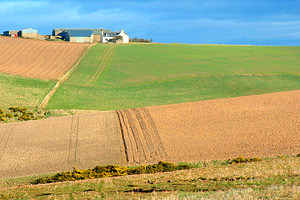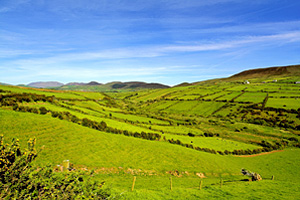High Nature Value Farming
Published on 4 February 2013 in Ecosystems and biodiversity
More traditional farming systems, those that have a large amount of moorland mixed with areas of grassland and woodland, still make up 30% of Europe’s agricultural land. Although they encourage biodiversity, these High Nature Value (HNV) farming systems are often economically unsound and so are in decline. Thanks to research by SRUC, and their partners, HNV systems are now a key priority in European legislation. All 27 members of the EU are required to monitor, support and maintain their existing HNV farming systems.

Key Challenges
Half of all species in Europe depend on agricultural habitats and these habitats were created by, and need to be maintained by, farming. However, agricultural intensification over the last 60 years has had a huge impact on the biodiversity of Europe’s farmland. Many previously common features, such as hedgerows, wetlands and semi-natural grasslands have been lost, and there now fewer varieties of animal and plant species. Halting our declining biodiversity is a huge challenge, reversing it an even bigger one.
Key Benefits
SRUC’s research has not only helped highlight the issues facing HNV farming systems and their wildlife across Europe but has also helped define the many and varied HNV systems which still exist and helped to estimate their extent and distribution.
Our findings have also illustrated why it is essential to gain a detailed understanding of how each HNV system works and how it supports the wildlife so reliant on it. This deeper understanding is vital to ensure that HNV farming systems do not simply become ‘working fossils’ but rather remain flexible to change, allowing them to become economically viable.
Thanks to research by SRUC, and their partners, HNV systems are now a key priority in European legislation. All 27 members of the EU are required to monitor, support and maintain their existing HNV farming systems.
SRUC, working in collaboration with others, has produced research that has influenced policy across Europe. All 27 EU Member States are now required to ensure that the Sustainable Land Management element of their 2007-2013 Rural Development Programmes are targeted at “…biodiversity and preservation of high nature value farming and forestry systems, water and climate change”. As part of this prioritisation, the EU requires that all 27 Member States (and parts thereof) need to:
- Identify the extent and characteristics of the HNV farming systems occurring within their Member State/region.
- Identify what steps they are taking to support and maintain HNV farming, especially through Rural Development Programmes (RDPs).
- Monitor changes to the area of land covered by HNV farming systems (and the nature values associated with HNV farming) as part of their monitoring of RDPs.
Already Romania and Bulgaria have assessed their HNV regions and put funding in place to support them. As the European Commission have confirmed that HNV farming will remain a key priority in 2014 – 2020, other Member States will need to do the same in the years to come.


Comments or Questions
Related Websites
Our Partners
UK Joint Nature Conservation Committee, Institute for European Environmental Policy (IEEP), World Wildlife Fund, European Forum on Nature Conservation & Pastoralism (EFNCP).
Find Out More
Visit Dr Davy McCracken's SRUC Research Profile, http://www.sruc.ac.uk/dmccrackenAuthor
Dr Davy McCracken Davy.Mccracken@sruc.ac.uk







